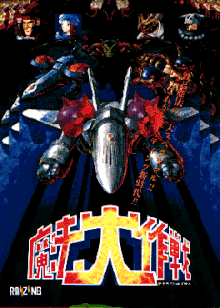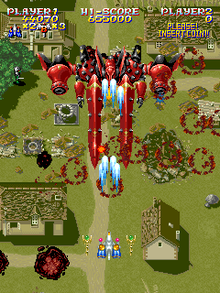
Zero Wing is a 1989 side-scrolling shooter arcade video game developed by Toaplan and originally published in Japan by Namco and in North America by Williams Electronics. Controlling the ZIG space fighter craft, players assume the role of protagonist Trent in a last-ditch effort to overthrow the alien space pirate organization CATS. It was the eighth shoot 'em up game from Toaplan, and their fourteenth video game overall.

Toaplan Co., Ltd. was a Japanese video game developer based in Tokyo responsible for the creation of a wide array of scrolling shooters and other arcade video games. The company was founded in 1979 but its gaming division was established in 1984 by former Orca and Crux employees, who wanted to make games, after both companies declared bankruptcy. Their first shoot 'em up game, Tiger-Heli (1985) on arcades, was a success and helped establish Toaplan as a leading producer of shooting games throughout the 1980s and 1990s that would continue to characterize their output.
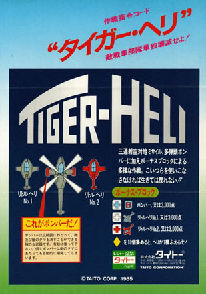
Tiger-Heli is a vertically scrolling shooter game developed by Toaplan and released for arcades in 1985. It was published in Japan by Taito and in North America by Romstar. Controlling the titular attack helicopter, the player must fight endless waves of military vehicles while avoiding collision with their projectiles and other obstacles. The Tiger-Heli has a powerful bomb at its disposal that can clear the screen of enemies when fired. It was the first shoot 'em up game from Toaplan, and their third video game overall.
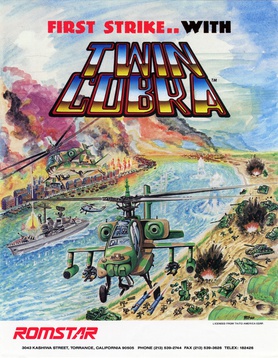
Twin Cobra, known as Kyukyoku Tiger in Japan, is a vertically scrolling shooter developed by Toaplan and released for arcades in 1987 by Taito in Japan and Europe, then in North America by Romstar. It is a sequel to the 1985 arcade game Tiger-Heli. Controlling the titular attack helicopter, the players must fight endless waves of military vehicles while avoiding collision with their projectiles and other obstacles. It was the fourth shoot 'em up game from Toaplan, and their tenth video game overall. It was ported to multiple platforms, with each done by different third-party developers that made several changes or additions.
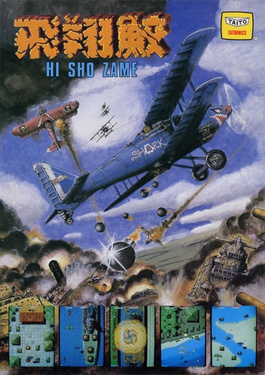
Flying Shark, known as Sky Shark in North America, is a vertically scrolling shooter arcade video game originally developed by Toaplan and published in 1987 by Taito in Japan, Romstar in North America and Electrocoin in Europe. Controlling the titular biplane, the players must fight endless waves of military vehicles while avoiding collision with their projectiles and other obstacles. The plane has a powerful bomb at its disposal that can clear a portion of the screen of bullets and damage enemies when fired. It was the third shoot 'em up game from Toaplan, and their eighth video game overall.
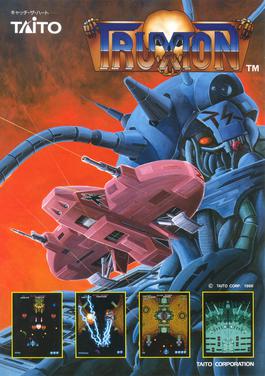
Truxton is a 1988 vertically scrolling shooter arcade video game originally developed by Toaplan and published in Japan and Europe by Taito, as well as in North America by Midway. Set in a future where the Gidans alien race led by Dogurava invaded the fictional planet Borogo, players assume the role of fighter pilot Tatsuo taking control of the Super Fighter ship on a last-ditch effort to overthrow the alien invaders.

Eighting Co., Ltd., stylized as 8ing, is a Japanese video game developer and publisher. It was formerly known as Raizing. It is known for its shoot 'em ups and its licensed fighting games.
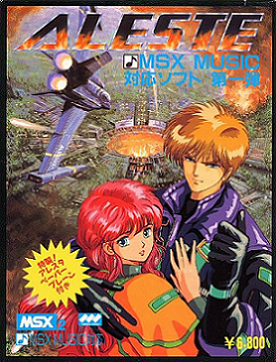
Aleste (アレスタ) is a vertically scrolling shooter developed by Compile, originally published by Sega in 1988 for the Master System and then by CP Communications for the MSX2. The Master System version was released outside Japan as Power Strike. The game spawned the Aleste and Power Strike franchises.
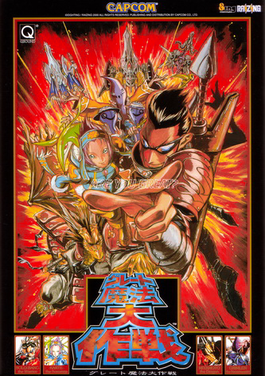
Dimahoo is a medieval-themed manic shooter video game developed by 8ing/Raizing and published by Capcom on the arcade cabinets in 2000. It was released in Japan as Great Mahou Daisakusen. It is a sequel to 1993's Sorcer Striker and 1994's Kingdom Grand Prix. The game's soundtrack was published by Suleputer.

Teki Paki is a 1991 puzzle arcade video game developed by Toaplan and published in Japan by Tecmo, Hong Kong by Honest Trading Co. and Taiwan by Spacy Co. Ltd.

Hellfire is a 1989 horizontally scrolling shooter arcade video game originally developed by Toaplan and published in Japan by Taito and North America by U.S.A. Games. The first horizontal shoot 'em up title to be created by Toaplan, the game takes place in the year 2998 where a space matter known as Black Nebula created by robot dictator Super Mech spreads and threatens to engulf human-controlled galaxies, as players assume the role of Space Federation member Captain Lancer taking control of the CNCS1 space fighter craft in a surprise attack to overthrow the enemies with the fighter craft's titular weapon.

Wardner is a side-scrolling platform game developed by Toaplan and published in arcades worldwide by Taito in 1987.

Slap Fight is a 1986 vertically scrolling shooter arcade video game developed by Toaplan and published by Taito. Set on the colonized fictional planet of Theron in the future, where an alien race led by Gaudy have invaded the human-controlled location, players assume the role of an Allied League of Cosmic Nations (ALCON) fighter pilot taking control of the SW475 space fighter craft in an effort to counterattack the invaders. Initially launched for the arcades, the game was later ported to other microcomputer and console platforms by various third-party developers, with each one featuring several changes or additions compared to the original release.

Kingdom Grand Prix is a scrolling shooter/racing hybrid arcade game developed by Raizing and published by Eighting. It was later ported to the Sega Saturn. It is the second entry in the Mahou Daisakusen series, but the first to be a shooter/racing hybrid.

Fire Shark is a 1989 vertically scrolling shooter arcade video game developed and published by Toaplan in Japan and Europe, and by Romstar in North America. It is the sequel to Flying Shark, a game released in 1987 on multiple platforms. Set in the year 1991, the game focuses on a mysterious armada launching a worldwide attack from a small island in the Mediterranean Sea. Players take control of the titular biplane to counterattack the enemy forces.
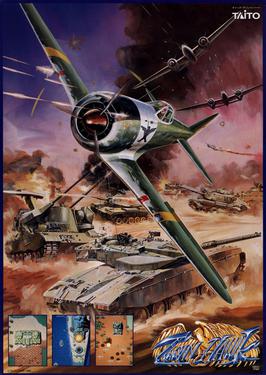
Twin Hawk is a 1989 vertically scrolling shooter arcade video game originally developed by Toaplan and published by Taito. Taking place at the end of an alternative World War II setting, where general Giovanni and his army plots to take over the fictional country Gorongo, players assume the role of a wing commander from the Daisenpū squadron taking control of a Flying Fortress fighter aircraft in an effort to overthrow the enemy.

Snow Bros. 2: With New Elves is a 1994 platform arcade video game developed and published by Toaplan under their Hanafram label. One of the last games to be created by Toaplan, it is the sequel to Snow Bros., which was released earlier in 1990 on multiple platforms. In the game, players assume the role of one of the playable characters to rescue a kidnapped princess from captivity.

Seirei Senshi Spriggan is a 1991 vertically scrolling shooter video game developed by Compile and published by Naxat Soft in Japan for the PC Engine CD-ROM². In the game, the player assume control of Jega and Rikart piloting the Spriggan in order to protect their country from the Buraizubara empire.
Yuichi Toyama is a Japanese video game designer, director, and producer. He used to work at Technosoft, Compile and Eighting, and is currently working at Taito since 2017. He is also a writer for the Game Culture Preservation Institute(IGCC).

Spriggan Mark 2: Re-Terraform Project is a 1992 horizontally scrolling shooter video game developed by Compile and published in Japan by Naxat Soft for the PC Engine Super CD-ROM². It is a follow-up to Seirei Senshi Spriggan (1991). The game follows lieutenant Greg Erwin piloting the armed Bartholomeu armor and later the Spriggan Mark 2 in a war between two opposing forces to decide the fate of a space colony at Mars. The player must fight against waves of enemies to avoid collision with their projectiles and other obstacles, while intermissions between characters during gameplay advances the storyline.
